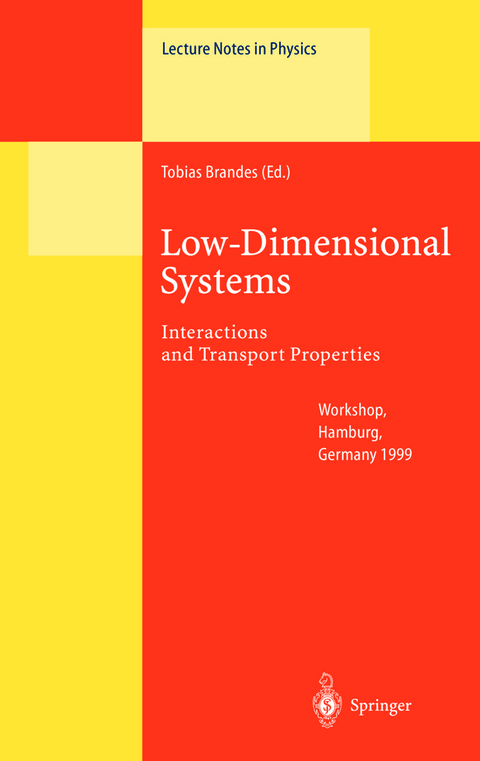
Low-Dimensional Systems
Interactions and Transport Properties
Seiten
2010
|
1. Softcover reprint of the original 1st ed. 2000
Springer Berlin (Verlag)
978-3-642-08660-1 (ISBN)
Springer Berlin (Verlag)
978-3-642-08660-1 (ISBN)
Lectures of a Workshop Held in Hamburg, Germany, July 27-28, 1999
Experimental progress over the past few years has made it possible to test a n- ber of fundamental physical concepts related to the motion of electrons in low dimensions. The production and experimental control of novel structures with typical sizes in the sub-micrometer regime has now become possible. In parti- lar, semiconductors are widely used in order to con?ne the motion of electrons in two-dimensional heterostructures. The quantum Hall e?ect was one of the ?rst highlights of the new physics that is revealed by this con?nement. In a further step of the technological development in semiconductor-heterostructures, other arti?cial devices such as quasi one-dimensional 'quantum wires' and 'quantum dots' (arti?cial atoms) have also been produced. These structures again di?er very markedly from three- and two-dimensional systems, especially in relation to the transport of electrons and the interaction with light. Although the technol- ical advances and the experimental skills connected with these new structures are progressing extremely fast, our theoretical understanding of the physical e?ects (such as the quantum Hall e?ect) is still at a very rudimentary level. In low-dimensional structures, the interaction of electrons with one another and with other degrees of freedoms such as lattice vibrations or light gives rise to new phenomena that are very di?erent from those familiar in the bulk ma- rial. The theoretical formulation of the electronic transport properties of small devices may be considered well-established, provided interaction processes are neglected.
Experimental progress over the past few years has made it possible to test a n- ber of fundamental physical concepts related to the motion of electrons in low dimensions. The production and experimental control of novel structures with typical sizes in the sub-micrometer regime has now become possible. In parti- lar, semiconductors are widely used in order to con?ne the motion of electrons in two-dimensional heterostructures. The quantum Hall e?ect was one of the ?rst highlights of the new physics that is revealed by this con?nement. In a further step of the technological development in semiconductor-heterostructures, other arti?cial devices such as quasi one-dimensional 'quantum wires' and 'quantum dots' (arti?cial atoms) have also been produced. These structures again di?er very markedly from three- and two-dimensional systems, especially in relation to the transport of electrons and the interaction with light. Although the technol- ical advances and the experimental skills connected with these new structures are progressing extremely fast, our theoretical understanding of the physical e?ects (such as the quantum Hall e?ect) is still at a very rudimentary level. In low-dimensional structures, the interaction of electrons with one another and with other degrees of freedoms such as lattice vibrations or light gives rise to new phenomena that are very di?erent from those familiar in the bulk ma- rial. The theoretical formulation of the electronic transport properties of small devices may be considered well-established, provided interaction processes are neglected.
Transport and Interactions in One Dimension.- Nonequilibrium Mesoscopic Conductors Driven by Reservoirs.- A Linear Response Theory of 1D-Electron Transport Based on Landauer Type Model.- Gapped Phases of Quantum Wires.- Interaction Effects in One-Dimensional Semiconductor Systems.- Correlated Electrons in Carbon Nanotubes.- Bosonization Theory of the Resonant Raman Spectra of Quantum Wires.- Transport and Interactions in Zero and Two Dimensions.- An Introduction to Real-Time Renormalization Group.- Spin States and Transport in Correlated Electron Systems.- Non-linear Transport in Quantum-Hall Smectics.- Thermodynamics of Quantum Hall Ferromagnets.
| Erscheint lt. Verlag | 7.12.2010 |
|---|---|
| Reihe/Serie | Lecture Notes in Physics |
| Zusatzinfo | VII, 219 p. |
| Verlagsort | Berlin |
| Sprache | englisch |
| Maße | 155 x 235 mm |
| Gewicht | 351 g |
| Themenwelt | Naturwissenschaften ► Physik / Astronomie ► Atom- / Kern- / Molekularphysik |
| Naturwissenschaften ► Physik / Astronomie ► Elektrodynamik | |
| Naturwissenschaften ► Physik / Astronomie ► Hochenergiephysik / Teilchenphysik | |
| Naturwissenschaften ► Physik / Astronomie ► Quantenphysik | |
| Naturwissenschaften ► Physik / Astronomie ► Theoretische Physik | |
| Technik ► Maschinenbau | |
| Schlagworte | Carbon Nanotubes • Electronic transport theory • Interactions in lower dimensions • mesoscopic systems • Nanotube • QHE • quantum dot • semiconductor • Solid state physics • thermodynamics |
| ISBN-10 | 3-642-08660-8 / 3642086608 |
| ISBN-13 | 978-3-642-08660-1 / 9783642086601 |
| Zustand | Neuware |
| Haben Sie eine Frage zum Produkt? |
Mehr entdecken
aus dem Bereich
aus dem Bereich
Buch | Softcover (2024)
Wiley-VCH (Verlag)
CHF 83,85


